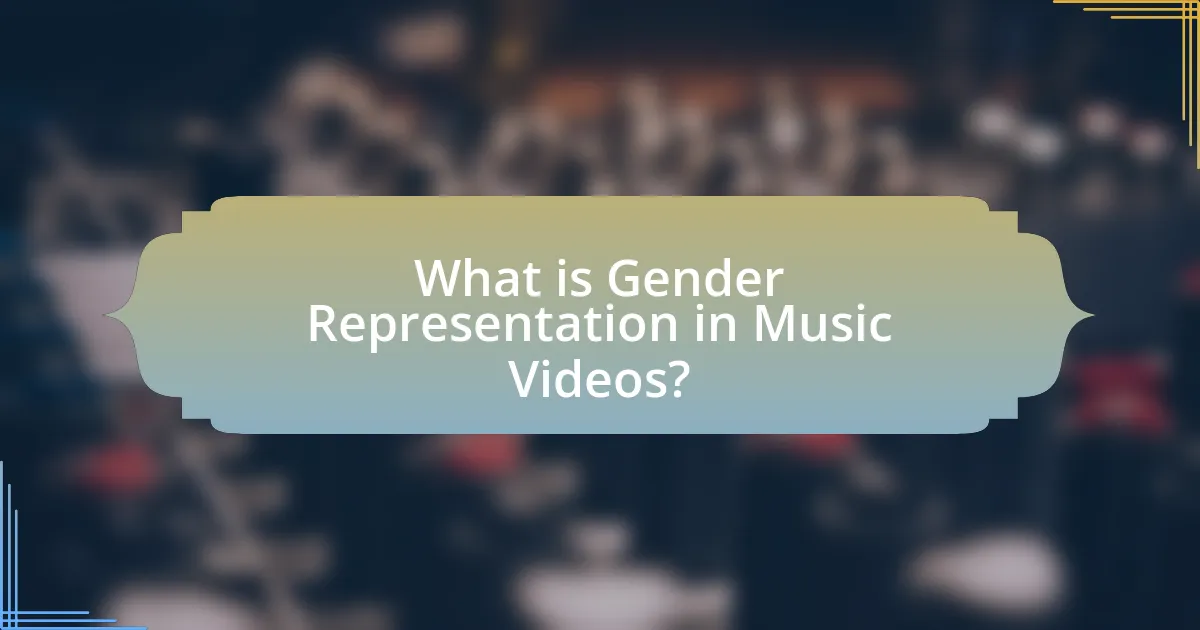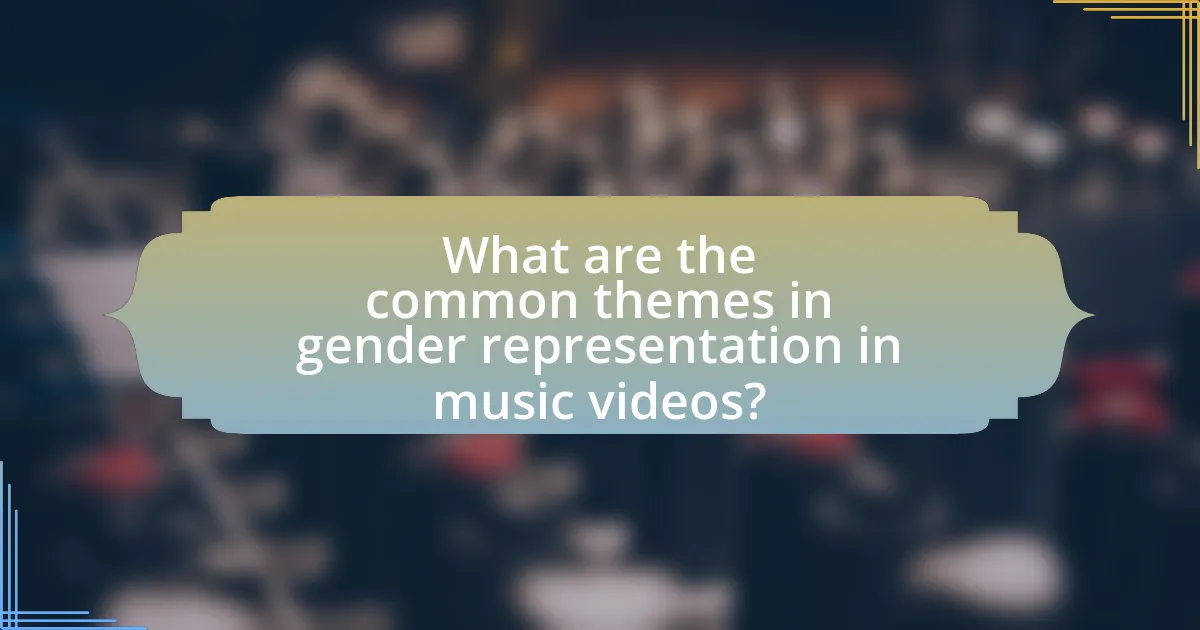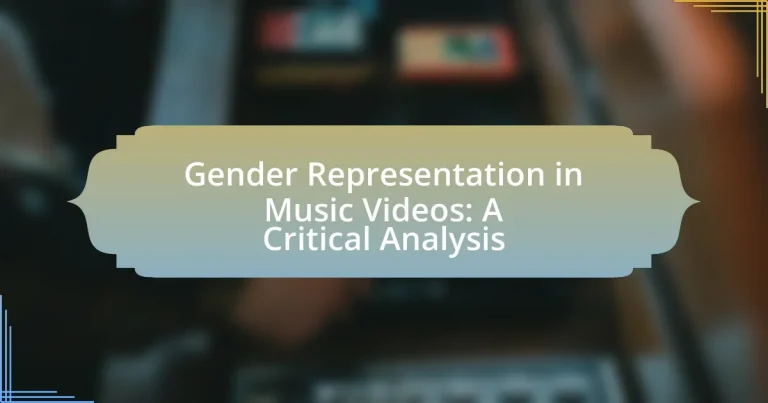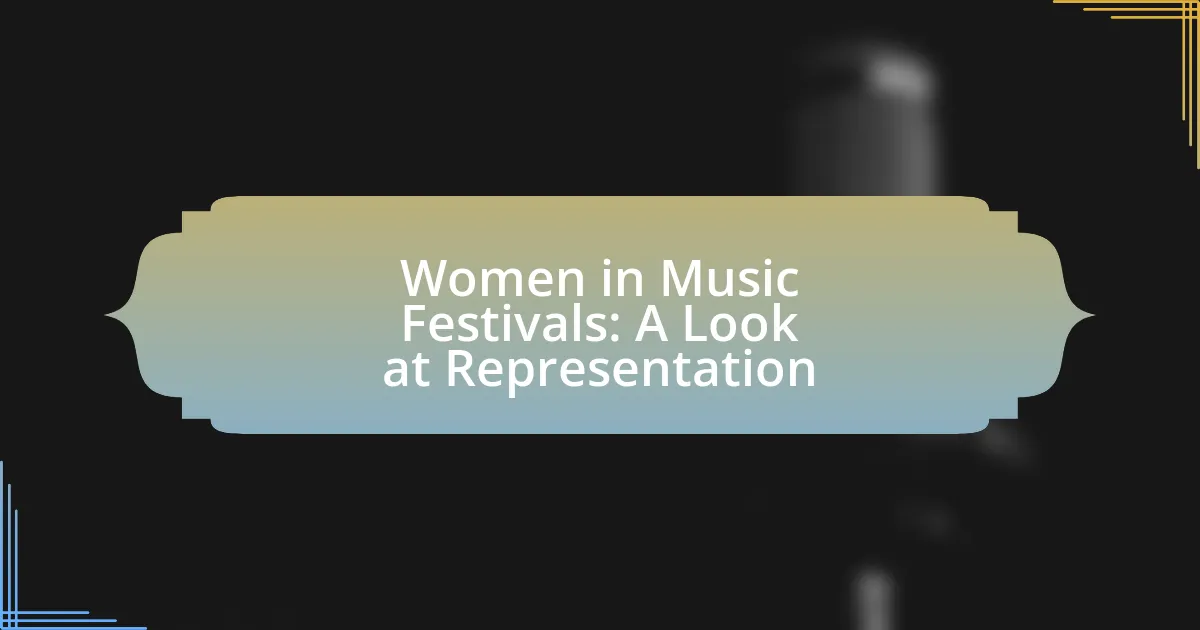Gender representation in music videos refers to how different genders, particularly men and women, are visually and thematically portrayed, reflecting societal norms and stereotypes. The article examines the historical evolution of these representations, highlighting the shift from hyper-sexualization in the 1980s to more empowered narratives in contemporary music videos. It discusses the impact of gender representation on societal norms, audience perceptions, and the perpetuation of stereotypes, emphasizing the importance of equitable representation in promoting diversity and challenging traditional gender roles. Additionally, the article outlines the challenges faced in addressing these issues within the music industry and suggests practical steps for improving gender representation in music videos.

What is Gender Representation in Music Videos?
Gender representation in music videos refers to the portrayal and depiction of different genders, particularly how men and women are visually and thematically represented in these media. This representation often reflects societal norms, stereotypes, and power dynamics, influencing public perceptions of gender roles. Research indicates that women are frequently depicted in sexualized ways, while men are often shown in dominant roles, reinforcing traditional gender stereotypes. For example, a study by the Geena Davis Institute on Gender in Media found that women are underrepresented in music videos, comprising only 29% of the characters, and are often portrayed in ways that emphasize their physical appearance rather than their agency or talents.
How is gender representation defined in the context of music videos?
Gender representation in the context of music videos is defined as the portrayal and depiction of different genders, particularly focusing on how these representations reflect, reinforce, or challenge societal norms and stereotypes. Research indicates that music videos often depict women in sexualized roles and men in dominant positions, which can perpetuate traditional gender roles. For instance, a study by the Geena Davis Institute on Gender in Media found that women are often shown in revealing clothing and performing passive roles, while men are typically portrayed as active and powerful. This pattern highlights the ongoing issues of gender inequality and the impact of visual media on public perceptions of gender.
What are the historical perspectives on gender representation in music videos?
Historical perspectives on gender representation in music videos reveal a significant evolution from the 1980s to the present. In the early years, particularly during the rise of MTV, female artists were often portrayed in hyper-sexualized ways, reinforcing traditional gender stereotypes. For instance, music videos by artists like Madonna and Cyndi Lauper showcased women as both empowered and objectified, reflecting a duality in representation.
As the 1990s progressed, the emergence of female empowerment themes became more pronounced, with artists like Alanis Morissette and TLC challenging conventional norms. This shift indicated a growing awareness of gender issues within the industry. However, the portrayal of women remained complex, often oscillating between empowerment and objectification.
In the 2000s and beyond, the rise of social media and digital platforms further transformed gender representation in music videos. Artists like Beyoncé and Nicki Minaj began to assert control over their images, using their platforms to challenge stereotypes and advocate for gender equality. This era also saw a diversification of representations, with more LGBTQ+ artists and narratives gaining visibility.
Overall, the historical perspectives on gender representation in music videos illustrate a trajectory from objectification to empowerment, reflecting broader societal changes in attitudes toward gender roles.
How has the portrayal of gender evolved over time in music videos?
The portrayal of gender in music videos has evolved significantly from the 1980s to the present, shifting from hyper-sexualized depictions to more nuanced representations. In the 1980s and 1990s, female artists often showcased their sexuality as a primary aspect of their image, exemplified by videos from artists like Madonna and Britney Spears, which emphasized provocative visuals. In contrast, the 2000s saw a gradual emergence of more empowered female narratives, as artists like Beyoncé and Lady Gaga began to challenge traditional gender roles and promote messages of independence and strength. Recent trends indicate a further diversification of gender representation, with artists such as Lil Nas X and Janelle Monáe openly exploring and celebrating non-binary and queer identities, reflecting broader societal changes in the understanding of gender. This evolution is supported by studies indicating that music videos now increasingly feature complex characters and storylines that go beyond mere objectification, aligning with contemporary discussions on gender equality and representation in media.
Why is gender representation important in music videos?
Gender representation is important in music videos because it shapes societal perceptions and influences cultural norms regarding gender roles. Music videos often serve as a visual medium that reflects and reinforces stereotypes; for instance, studies have shown that women are frequently depicted in sexualized roles, which can perpetuate harmful views about femininity and objectification. Research by the Geena Davis Institute on Gender in Media indicates that only 30% of speaking characters in music videos are female, highlighting a significant gender imbalance that can affect audience attitudes and expectations. Therefore, equitable representation in music videos is crucial for promoting diversity, challenging stereotypes, and fostering a more inclusive cultural landscape.
What impact does gender representation have on societal norms?
Gender representation significantly influences societal norms by shaping perceptions of gender roles and expectations. When media, including music videos, portray diverse and equitable representations of genders, they challenge traditional stereotypes and promote a more inclusive understanding of identity. Research indicates that exposure to balanced gender representation can lead to more progressive attitudes towards gender equality, as evidenced by a study published in the Journal of Communication, which found that individuals exposed to non-stereotypical portrayals were more likely to support gender equality initiatives. Thus, the way genders are represented in music videos directly impacts societal norms by either reinforcing or challenging existing beliefs about gender roles.
How does gender representation influence audience perceptions?
Gender representation significantly influences audience perceptions by shaping societal norms and expectations regarding gender roles. Research indicates that media portrayals, including music videos, often reinforce stereotypes, which can lead to the internalization of these roles by viewers. For instance, a study by Smith et al. (2018) found that women are frequently depicted in sexualized roles, which can affect how audiences perceive women’s agency and capabilities in real life. This representation can lead to skewed perceptions of gender equality and influence behaviors and attitudes towards gender in various contexts.

What are the common themes in gender representation in music videos?
Common themes in gender representation in music videos include objectification, empowerment, and traditional gender roles. Objectification often manifests through the portrayal of women as sexual objects, emphasizing physical appearance over personality or talent, which is evident in many mainstream pop and hip-hop videos. Empowerment themes frequently showcase women in positions of strength and independence, challenging stereotypes, as seen in videos by artists like Beyoncé and Nicki Minaj. Traditional gender roles are reinforced through narratives that depict men as dominant and women as submissive, a pattern observable in various genres. These themes reflect broader societal attitudes towards gender and influence audience perceptions, as supported by studies such as “The Representation of Gender in Music Videos” by Smith et al., which analyzes the impact of visual media on gender norms.
How do different genres of music portray gender?
Different genres of music portray gender through distinct themes, imagery, and lyrical content that reflect societal norms and stereotypes. For instance, pop music often emphasizes traditional gender roles, showcasing women as objects of desire and men as dominant figures, which can be seen in the works of artists like Britney Spears and Justin Timberlake. In contrast, hip-hop frequently addresses issues of masculinity and power, often portraying women in a hypersexualized manner, as evidenced by lyrics from artists like Lil Wayne and Nicki Minaj. Rock music, on the other hand, has historically presented a more rebellious view of gender, with female artists like Joan Jett challenging norms and asserting independence. Studies, such as those conducted by the University of Southern California, reveal that these portrayals can influence listeners’ perceptions of gender roles, reinforcing or challenging existing stereotypes.
What are the differences in gender representation between pop and hip-hop music videos?
Pop music videos typically portray women in a more diverse range of roles, emphasizing empowerment, individuality, and emotional expression, while hip-hop music videos often depict women in more objectified and sexualized manners, reinforcing traditional gender stereotypes. Research by the Geena Davis Institute on Gender in Media indicates that women in pop videos are more likely to be shown in leadership roles or as independent characters, whereas hip-hop videos frequently feature women primarily as objects of desire, which can perpetuate harmful stereotypes. This contrast highlights the broader cultural narratives surrounding gender in these two genres, with pop music often promoting a more progressive representation compared to the more regressive portrayals found in hip-hop.
How do cultural contexts affect gender representation in music videos?
Cultural contexts significantly influence gender representation in music videos by shaping the portrayal of masculinity and femininity according to societal norms and values. For instance, in Western cultures, music videos often emphasize hypersexualized images of women, reflecting broader societal trends of objectification, while in some non-Western cultures, representations may align more closely with traditional gender roles, showcasing women in domestic or familial settings. Research by Frith and McRobbie (1990) highlights that these portrayals are not merely artistic choices but are deeply rooted in cultural expectations and historical contexts, which dictate how gender is visually constructed and understood in media.
What stereotypes are often perpetuated in music videos?
Music videos often perpetuate stereotypes related to gender roles, objectification, and racial identities. For instance, female artists are frequently depicted in sexually suggestive ways, reinforcing the stereotype that women are primarily valued for their physical appearance. Studies, such as those conducted by the Geena Davis Institute on Gender in Media, reveal that women are often shown in revealing clothing and engaging in behaviors that emphasize their sexuality, while men are portrayed as dominant and aggressive. Additionally, racial stereotypes are evident, with artists from minority backgrounds often depicted in roles that align with societal biases, such as hypersexualization or criminality. This representation can influence public perception and reinforce harmful stereotypes, as highlighted in research published in the Journal of Broadcasting & Electronic Media, which discusses the impact of media portrayals on societal attitudes.
How do these stereotypes affect the portrayal of women in music videos?
Stereotypes significantly affect the portrayal of women in music videos by often reducing them to hyper-sexualized and objectified roles. This portrayal reinforces societal norms that prioritize physical appearance and sexual appeal over individuality and talent. Research by the Geena Davis Institute on Gender in Media found that women are frequently depicted in ways that emphasize their bodies rather than their skills, with 70% of female characters in music videos being shown in sexually suggestive contexts. Such representations contribute to the perpetuation of harmful stereotypes, influencing audience perceptions and expectations of women in both media and real life.
What are the implications of male stereotypes in music videos?
Male stereotypes in music videos often perpetuate harmful notions of masculinity, leading to societal implications such as the reinforcement of aggressive behavior and emotional suppression among men. These portrayals can normalize the idea that men must be dominant, hypersexual, and emotionally stoic, which can adversely affect both male identity and interpersonal relationships. Research indicates that exposure to such stereotypes can influence young men’s attitudes towards gender roles, contributing to a culture that values aggression and devalues vulnerability. For instance, a study published in the Journal of Broadcasting & Electronic Media found that frequent exposure to stereotypical male imagery in media correlates with increased acceptance of traditional gender roles among viewers.

How can we critically analyze gender representation in music videos?
To critically analyze gender representation in music videos, one must examine the portrayal of gender roles, stereotypes, and the visual and lyrical content that reflects societal norms. This analysis involves identifying how male and female characters are depicted, the power dynamics between them, and the overall message conveyed regarding gender identity. Research indicates that music videos often reinforce traditional gender stereotypes, with women frequently portrayed in sexualized roles while men are depicted as dominant figures (Baker, 2016, “Gender Representation in Music Videos,” Journal of Media Studies). By applying frameworks such as feminist theory and media literacy, analysts can deconstruct these representations and assess their impact on audience perceptions and cultural narratives.
What methodologies are used in analyzing gender representation?
Content analysis, qualitative analysis, and feminist theory are methodologies commonly used in analyzing gender representation. Content analysis systematically examines music videos to quantify the presence and portrayal of gender roles, often using coding schemes to categorize visual and lyrical elements. Qualitative analysis involves in-depth interpretation of themes, narratives, and characterizations related to gender, allowing for a nuanced understanding of representation. Feminist theory critiques the power dynamics and societal norms reflected in media, providing a framework for understanding how gender is constructed and challenged in music videos. These methodologies collectively enable researchers to assess the complexities of gender representation in visual media.
How do visual and narrative elements contribute to gender representation analysis?
Visual and narrative elements significantly contribute to gender representation analysis by shaping perceptions and reinforcing stereotypes. In music videos, visual elements such as camera angles, lighting, and costume choices often depict gender roles, with women frequently portrayed in sexualized manners while men are shown as dominant figures. Narrative elements, including plotlines and character development, further influence how gender identities are constructed and understood. For instance, studies have shown that music videos often perpetuate traditional gender norms, with women depicted in passive roles and men in active ones, thereby affecting societal attitudes towards gender. This analysis is supported by research from the Journal of Gender Studies, which highlights the correlation between visual representation and audience interpretation of gender roles in media.
What role does audience reception play in the analysis of gender representation?
Audience reception plays a crucial role in the analysis of gender representation by influencing how gender roles and stereotypes are interpreted and understood. The way audiences engage with music videos can shape their perceptions of gender norms, as viewers bring their own experiences and cultural contexts to the interpretation of visual content. Research indicates that audience reactions can either reinforce or challenge existing gender stereotypes, as seen in studies where diverse audience demographics respond differently to the same content, highlighting the variability in interpretation based on factors such as age, gender, and cultural background. For instance, a study by Frith and McRobbie (1990) demonstrated that young women often negotiate their identities through the consumption of music videos, reflecting a complex interplay between media representation and personal identity formation. This underscores the importance of audience reception in understanding the impact of gender representation in media.
What are the challenges in addressing gender representation in music videos?
The challenges in addressing gender representation in music videos include entrenched stereotypes, industry norms, and audience expectations. Stereotypes often dictate how genders are portrayed, with women frequently depicted in sexualized roles while men are shown as dominant figures. Industry norms perpetuate these representations, as record labels and producers may prioritize content that aligns with traditional gender roles to maximize marketability. Additionally, audience expectations can reinforce these portrayals, as viewers may gravitate towards familiar tropes, making it difficult for artists to break away from established patterns. Research indicates that music videos often reflect and reinforce societal norms, making it challenging to achieve equitable representation.
How do industry practices hinder progress in gender representation?
Industry practices hinder progress in gender representation by perpetuating stereotypes and limiting opportunities for women in music videos. The predominance of male directors and producers often results in content that objectifies women, reinforcing traditional gender roles. For instance, a study by the Geena Davis Institute on Gender in Media found that only 29% of speaking characters in music videos are female, highlighting the underrepresentation of women in influential roles. Additionally, the focus on male-centric narratives and visual aesthetics marginalizes female artists, making it difficult for them to gain visibility and recognition. This systemic bias in industry practices ultimately stifles diversity and equality in gender representation within the music video landscape.
What are the barriers to changing stereotypes in music videos?
Barriers to changing stereotypes in music videos include entrenched industry norms, audience expectations, and economic pressures. The music industry often perpetuates existing stereotypes due to a reliance on proven formulas that attract viewers and generate revenue. Research indicates that audiences frequently prefer familiar representations, which discourages innovation and reinforces traditional gender roles. Additionally, financial constraints can limit the willingness of producers and artists to take risks in their content, as they may fear alienating their target demographic or losing sponsorships. These factors collectively create a challenging environment for altering stereotypes in music videos.
What practical steps can be taken to improve gender representation in music videos?
To improve gender representation in music videos, creators should implement diverse casting practices that prioritize equal representation of genders in both lead and supporting roles. Research indicates that music videos often reflect societal norms, and by consciously selecting a balanced mix of male and female performers, the industry can challenge stereotypes and promote inclusivity. Additionally, involving women in key production roles, such as directors and producers, can lead to more authentic portrayals of female experiences. A study by the Annenberg Inclusion Initiative found that only 16% of music videos featured female directors, highlighting the need for increased female leadership in the industry. Furthermore, setting industry standards or guidelines for gender representation can encourage accountability among creators and promote a culture of equality in music video production.
How can artists and producers promote positive gender representation?
Artists and producers can promote positive gender representation by consciously creating content that showcases diverse and empowered portrayals of all genders. This includes featuring strong female characters in leading roles, avoiding stereotypes, and ensuring equal representation in both on-screen talent and behind-the-scenes roles. Research indicates that media representation significantly influences societal perceptions; for instance, a study by the Geena Davis Institute on Gender in Media found that female characters in film and television are often underrepresented, which can perpetuate harmful stereotypes. By prioritizing balanced gender representation, artists and producers can contribute to a more equitable media landscape and challenge existing biases.
What role do audiences play in advocating for better gender representation?
Audiences play a crucial role in advocating for better gender representation by actively demanding diverse and equitable portrayals in media, including music videos. Their collective voice influences industry standards and practices, as evidenced by movements like #MeToo and Time’s Up, which have highlighted the need for gender equality in entertainment. Research indicates that when audiences express dissatisfaction with gender representation, it prompts creators and producers to reconsider their content strategies, leading to more inclusive narratives. For instance, a study by the Geena Davis Institute on Gender in Media found that increased audience awareness and advocacy can significantly impact the representation of women in film and television, demonstrating the power of audience engagement in driving change.





